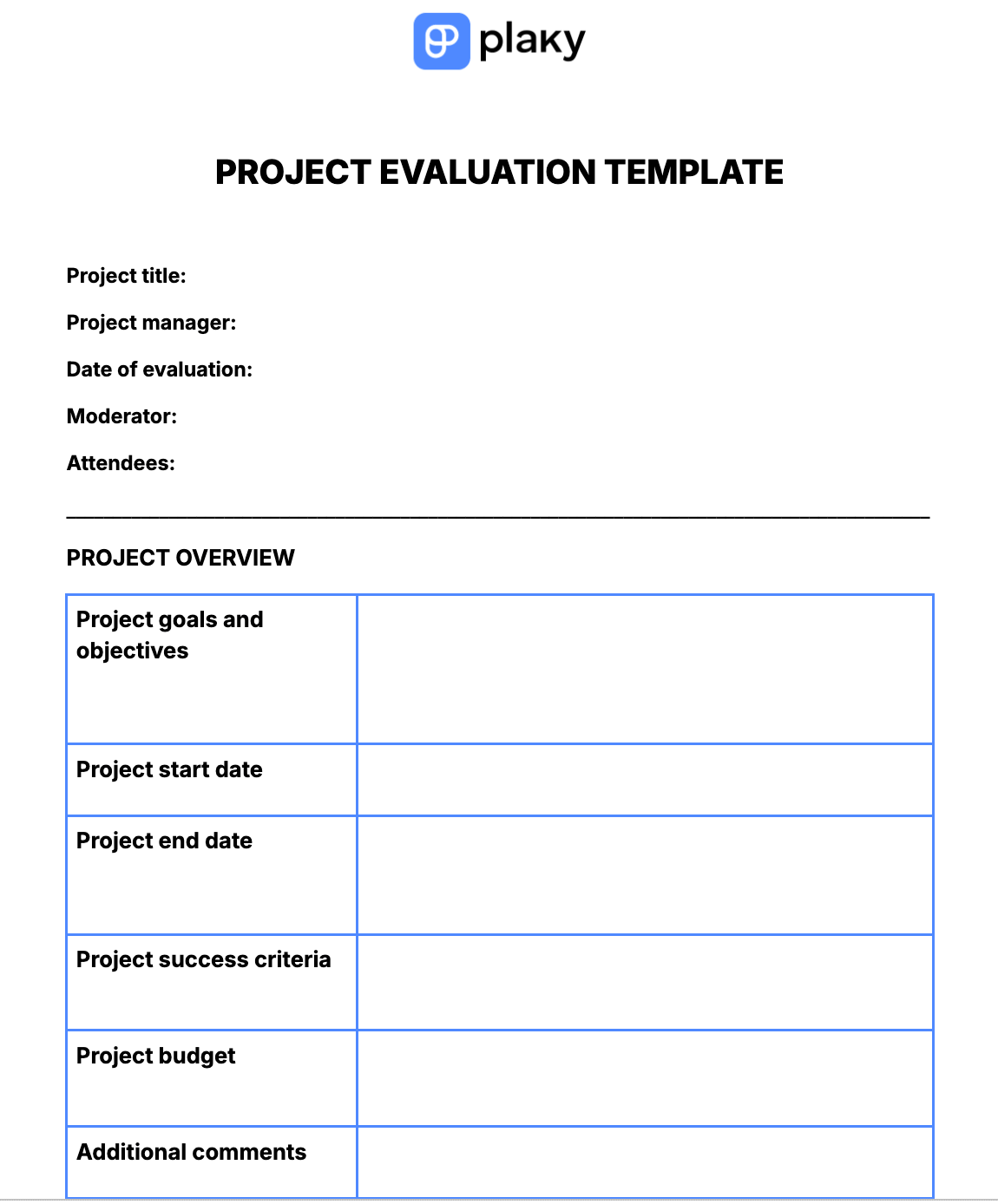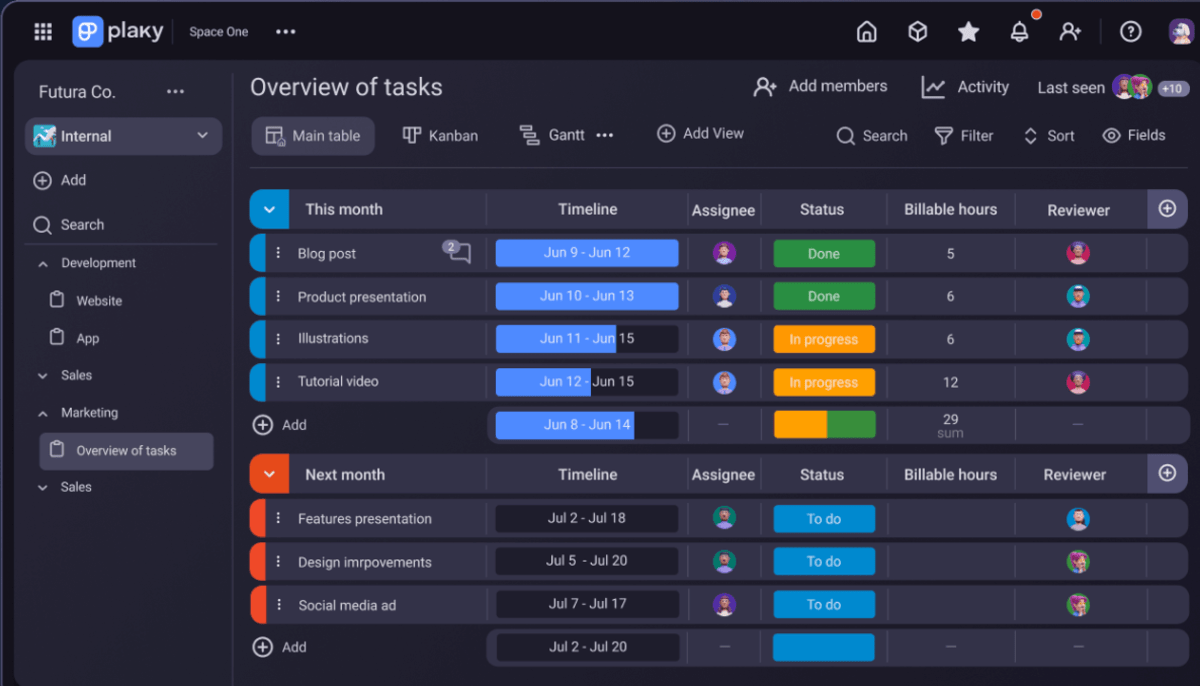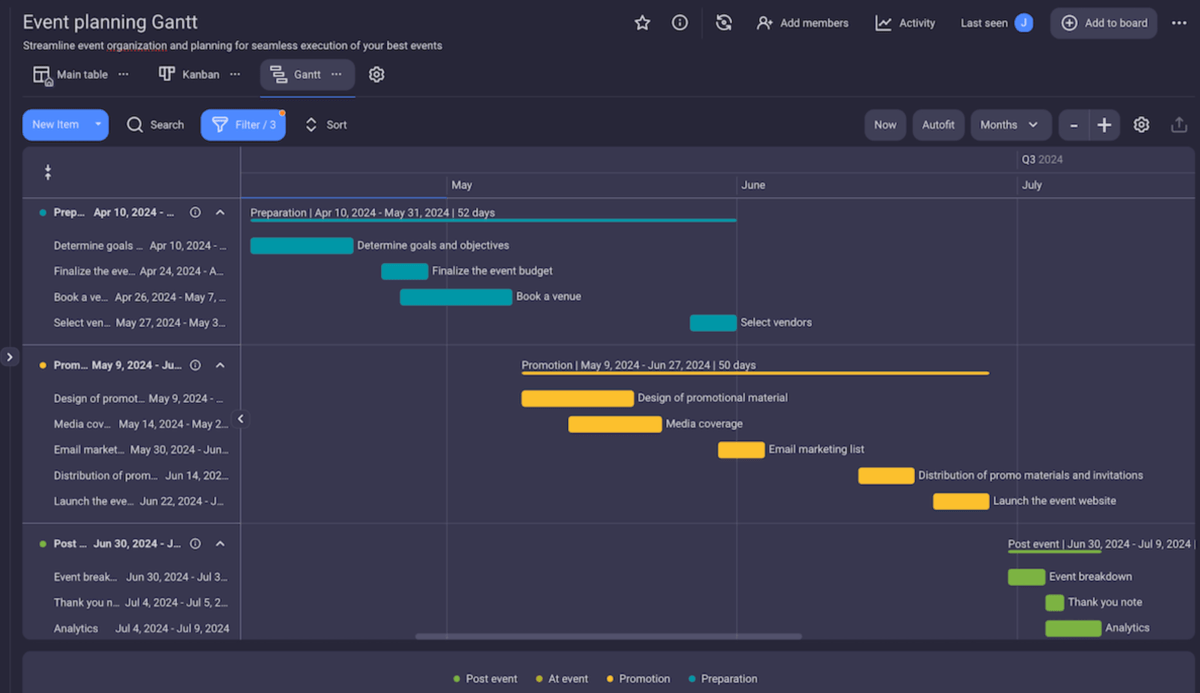Guiding a project without regular project evaluation is much the same as going forest trekking without proper equipment.
You can try it, but chances are you’ll quickly get disoriented, or worse — get completely lost.
In project management, project evaluation is the project’s fellow traveler with a compass. Its findings can help you make informed decisions and steer your project to success.
Stick with us to learn what project evaluation is, what types of project evaluation you can use, and what steps you need to take to do it right.
There is also a project evaluation template waiting for you, so let’s dive in!

In this article:
What is project evaluation?
Project evaluation is a systematic analysis of all relevant project data with the aim of checking if a project meets its goals and objectives. The evaluation helps project managers spot any road bumps and areas for improvement on time.
Bear in mind that every project is unique, meaning there is no one-size-fits-all approach to the evaluation process. Therefore, depending on the project’s nature, the project team can opt for different metrics when checking project performance.
From ROI and CPI to resource utilization and the number of change requests, every project has a particular metric that should be tracked.
The market offers a range of project dashboards and different types of project tracking software that can greatly facilitate the evaluation process.
💡 Plaky Pro Tip
Key performance indicators (KPIs) are the metrics project managers use to measure the success of their projects. Here are the 30 KPIs that you may want to use in your projects depending on your evaluation needs:
Types of project evaluation
A project’s life cycle is truly dynamic and — while you can do the evaluation whenever you find it necessary — there are 3 types of project evaluation you can do based on the key moments when a proper assessment is highly desirable:
- Pre-project evaluation,
- Ongoing project evaluation, and
- Post-project evaluation.
Pre-project evaluation
In general, pre-project evaluation is done before the project execution. As you write a project charter, you actually pre-evaluate the project.
This is also the moment when involving stakeholders is a must since everyone should be aligned in terms of project goals and objectives.
The aim of pre-project evaluation is to assess a project’s feasibility and identify potential risks and challenges before you embark on the project execution phase.
Ongoing project evaluation
Ongoing evaluation takes place in real time, as the project progresses. This type of evaluation puts project metrics into action.
Once the project is underway, your project team can evaluate the current project performance and see whether it stays within budget and schedule.
Also, as you monitor progress, you can analyze the work quality and make sure milestones are met.
In case you notice any impediments in your project execution, you can address them on time and enable your team members to stay on track.
Post-project evaluation
Finally, after you wrap up your project, it’s time to assess the project outcomes and see if they meet the previously agreed and expected goals and objectives.
This requires you to analyze every aspect of the project to understand what worked well and what you can improve in future projects.
Post-project evaluation is also sometimes referred to as the post-implementation review (PIR).
The findings of the post-project evaluation process are later stored in a repository and known as lessons learned.
A 5-step guide to an effective project evaluation process
The project evaluation process isn’t all fun and games. Depending on the desired project outcomes, project managers will choose the tools and metrics that best fit the evaluation targets.
Follow the next steps to get the best results out of your project assessment.
Step #1: Draw up a project evaluation plan
Before you get down to creating a project evaluation plan, you need to have a clear project plan with well-defined goals and objectives.
Your evaluation plan depends on the project itself, and it is highly recommended that you consult stakeholders for directions. By knowing their criteria for project success, you can choose the right evaluation method for data collection to create an evaluation timeline.
For example, let’s say you’re organizing an event, and one of the goals is to measure attendees’ satisfaction. In that case, you can collect data for this metric through the number of check-ins, social media engagement, or post-event surveys.
Step #2: Carry out project evaluation
Your evaluation plan will look different depending on the evaluation type you opt for. Here are the key activities you need to focus on for each type of evaluation:
- Pre-project evaluation — the aim is to evaluate the project’s feasibility i.e., its technical, legal, financial, and operational aspects. In addition, you should identify potential risks and assess the impact the project will have. Understanding the interests of all stakeholders and aligning them with project and organizational goals is cardinal.
- Ongoing evaluation — this evaluation is carried out while the project is underway. The main element is to monitor progress in terms of budget, schedule, and overall work quality. This way, you can detect potential budget fluctuations, current delivery issues, and team performance. Ongoing evaluation also enables you to identify bottlenecks and challenges on time so that you can address them properly and stay on track.
- Post-project evaluation — done after the project is completed. The focus is to evaluate the project’s success and impact through a detailed review of the overall project performance. Post-project evaluation is expected to show whether the project outcomes match the original project goals and objectives. Also, at this point, you can get information on stakeholders’ satisfaction with the project results, document lessons learned, and consider areas for improvement.
Step #3: Gather reliable data
After you carry out the evaluation, it’s time to get your ducks in a row and gather reliable data.
Feel free to combine both qualitative data, such as budget spent and elapsed time, and quantitative data, like satisfaction surveys and interviews, to check the impact of your project.
The collected data will provide detailed information on the project’s performance, allowing you to get down to business and carry out the analysis.
Collect key project performance data in Plaky
Step #4: Analyze the data
Once you have the necessary data at your disposal, analyze the findings against the original goals, i.e., check if you’ve carried out the project successfully.
The analysis is expected to show what has worked well and what hasn’t worked at all. Also, you’ll not only spot the areas that need improvement but also bring best practices to the fore.
Step #5: Report the findings and consider your next steps
When you are done with the analysis, it’s time to craft a report and share it with your project team, stakeholders, and sponsors.
A project evaluation report should include information on:
- Evaluation process,
- Key findings,
- Areas for improvement,
- Risk management,
- Time compliance,
- Team performance,
- Budget analysis, and
- Overall work quality.
Don’t forget to draw lessons learned from your evaluation findings as they are invaluable assets for the entire organization and can significantly improve your team and budget performance in the future.
Besides that, remember to adapt the report to suit your audience’s preferences. For example, your stakeholders might prefer to have a face-to-face meeting whereas your team members might fancy getting a PDF version of the report with various kinds of graphs and charts.
Either way, sharing the results of your project evaluation can have an enormous impact on future projects and practices.
By communicating the findings to your team and stakeholders, you prepare the ground for open discussions and constructive suggestions for future refinements and updates. So, if properly applied, lessons learned from the completed project can add up to continuous improvement of future projects.
Free project evaluation template
Whenever you decide to evaluate your projects, feel free to use this project evaluation template as a starting point.
Get Plaky’s project evaluation template

FAQs about project evaluation
If you are still not sure about the effectiveness of project evaluation or how to improve the process, here are some FAQs to help you clear things up.
What are the benefits of project evaluation?
Project evaluation is vital for projects, teams, and organizations because it:
- Enhances team performance — by evaluating the team’s performance and timely task delivery, you increase accountability and develop a sense of shared responsibility.
- Engages stakeholders in the project evaluation process — keeping stakeholders informed about the project and asking for their feedback contributes to better collaboration and fosters trust.
- Keeps projects on the right track — by keeping track of how well your project meets the original goals and objectives, evaluation helps you make adjustments and stay on course.
- Fine-tunes project planning — project evaluation findings have a great impact on future projects because you can use lessons learned to perfect project planning.
- Brings areas for improvement to light — evaluation provides a clear insight into positive and negative practices used during project planning and execution and detects areas for improvement.
What are the best practices for project evaluation?
Here are some of the best practices to follow for a comprehensive project evaluation:
- Use the right data and metrics — try to use correct and relevant data and monitor metrics that will give results and fulfill your evaluation objectives. Otherwise, you can get false conclusions, and the evaluation process loses credibility.
- Collect data in a timely manner — make sure that you collect data at the right time, e.g., when your project reaches certain milestones or deadlines pass for certain tasks. This way, you ensure a more accurate evaluation.
- Conduct an in-depth analysis — for an effective evaluation process, you need to avoid superficial analysis. Take time to consider all positive aspects and setbacks and base your findings on thorough analysis.
- Record lessons learned — never forget to keep track of lessons learned as they are an invaluable source of wisdom you can use for future reference.
- Offer recommendations you can put into effect — if your evaluation findings highlight certain stumbling blocks, offer actionable solutions and apply them before the current project is derailed or use them to improve future projects.
What is the best project evaluation method?
The correct answer to this question depends on the very nature of the project and what you want to achieve with the evaluation. No project is the same, so the best way to assess your projects is to combine quantitative and qualitative metrics for analysis.
Essentially, make sure you identify the evaluation’s purpose, choose the right metrics, and carefully plan how and when you will carry out the evaluation.
Enhance project evaluation with Plaky
Obviously, proper evaluation is one of the keys to success as far as project management goes. But, you will not get far by trying to gloss over any imperfections just to speed the whole process along.
There is no place for mistakes and inaccuracies in the project evaluation process. That’s why complex projects need support in the form of a tool that will gather all project data in one place and give you a bird’s-eye view of timelines, resources, and expenses.
To ensure successful project evaluation, precision is crucial — and there’s no better way to guarantee an accurate project assessment than with project tracking software.
And that’s exactly where Plaky comes in.

Plaky is a budget-friendly tool that helps you manage and monitor your projects from the planning to the closure phase. Better yet, it acts as a centralized hub for your project data, making it easy to evaluate all your endeavors as they progress.
After you set the task information structure and add assignees and relevant project documentation, use Plaky to visualize that data in a different view — Table (the default one), Kanban, or Gantt view.
The Gantt view might be the best choice for an ongoing project evaluation process because it helps you to:
- Visually depict tasks and timelines in a horizontal bar format,
- Easily detect potential delays and bottlenecks,
- Identify overlapping tasks and drag and drop them to adjust schedules, and
- Personalize task organization according to project requirements.
Plaky automatically calculates the duration of all tasks within a specific project stage too, which should help you in further planning and scheduling. Plus, you’ll have an accurate log of all board changes — so nothing will slip through the cracks during an ongoing project.

You can even use Plaky’s Gantt charts to define grouping and labeling criteria. With these additional view settings, you can easily see if any team member is overbooked and also keep an eye on individual task progress and current status. Quite handy, right?
But that’s not all.
Whatever industry you are in, you can use Plaky to plan, execute, monitor, and evaluate all your projects — no matter how complex they are OR how fast your company grows.
With Plaky, you’ll forget all about inaccurate spreadsheets and easily delegate tasks, set timelines, and collaborate with team members.
So, what are you waiting for? Make project evaluation a breeze with Plaky. Sign up for a free account today.

